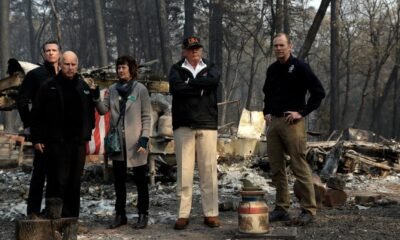arizona
Raging Clair Fire Engulfs 50 Acres Near Horseshoe Reservoir, Forces Campground Evacuation

The fire is burning southwest of Horseshoe Lake Reservoir and off of Forest Road 205. Here are the latest details.
MARICOPA COUNTY, Ariz. — Crews in Tonto National Forest are battling several fires that were caused by monsoon storms on Sunday, one of which is the Clair Fire, near Horseshoe Lake Reservoir.
The Clair Fire is burning southwest of the reservoir, off of Forest Road 205 in Maricopa County, according to a post from the Tonto National Forest on Facebook.
Officials estimate that the Clair Fire has burned about 50-60 acres.
The Horseshoe Lake Campgrounds have been evacuated due to the Clair Fire.
There are currently no road restrictions.
The Clair Fire is one of nine fires that were sparked when a round of monsoon thunderstorms that had lightning and high winds hit the Tonto National Forest.
The forest says resources are being sent out to fight all of the fires and is prioritizing fires based on threats to communities and structures.
This is a developing story and more details will be added as they are made available.
Residents in wildfire-prone areas are urged to have an emergency supplies kit to bring with them of they are evacuated from their homes, especially as Arizona residents are beginning to see early widespread fire activity throughout the state.
An emergency supply kit should be put together long before a wildfire or another disaster occurs. Make sure to keep it easily accessible so you can take it with you when you have to evacuate.
The National Fire Protection Association (NFPA) recommends that residents near a disaster store emergency supplies in a plastic tub, small suitcase, trash can, backpack, or other containers.
Residents should make sure they have the necessities, such as three gallons of water per person and a three-day supply of ready-to-eat food, the NFPA said. A first-aid kit, prescription medications, contact lenses, and non-prescription drugs should also be taken into account.
Copies of any important family documents, including insurance policies, identification, bank account records, and emergency contact numbers should also be taken and put into a waterproof, portable container in your kit, the NFPA said.
The association lists other items that would help in a disaster, including:
Sleeping bag or warm blanket for each person. Battery-powered or hand-cranked radio and a NOAA weather radio to receive up-to-date information. Dust mask or cotton T-shirt to filter the air. Matches in a waterproof container. Complete change of clothing including long pants, long sleeve shirts, and sturdy shoes stored in a waterproof container. Signal flare.
Those in Arizona who have been affected by a wildfire or other natural disasters can seek assistance from the American Red Cross by calling 1-800-842-7349.
If evacuations are required due to a wildfire, they will be issued using the ‘Ready, Set, Go’ method, according to the Arizona Emergency Information Network.
If a ‘Ready’ alert is issued, that means you need to be aware of hazards that can threaten your community and make sure you have an emergency kit ready to go with enough supplies to last 72 hours.
If a ‘Set’ alert is issued, that means that you should consider voluntarily evacuating to a shelter or go to family or friends who are outside of the evacuation zone.
If a ‘Go’ alert is issued that means you need to evacuate immediately.
You can learn more about the ‘Ready, Set, Go’ system by clicking here.
The Arizona Fire & Medical Authority has released tips on how to prevent fires from starting in your home.
“More than 4,000 Americans die each year in fires and approximately 25,000 are injured,” the authority said on its website. “An overwhelming number of fires occur in the home.”
First off, the authority says that every house needs to have at least one working smoke alarm. Every level of the home and every sleeping area should have a working smoke alarm inside of it to offer the best protection.
Appliances should also be used in a way that manufacturers recommend, since overheating, shorts and sparks can all lead to a fire breaking out.
Lastly, families should have an escape plan from every room of the house.
“Caution everyone to stay low to the floor when escaping from fire and never to open doors that are hot,” the authority said. “Select a location where everyone can meet after escaping the house. Get out then call for help.”
The authority offers free home safety inspections. Schedule one with them by calling 623-544-5400.
With temperatures beginning to heat up, fires are likely to continue, but there are some ways that you can prevent them from starting.
According to the Arizona Department of Forestry and Fire Management, some ways to prevent a wildfire from sparking include:
Make sure a campfire is out by dousing it with water, stirring it and repeating until it is cool to the touch when you touch it with the back of your hand. Refrain from using a chainsaw or welding equipment during windy or high fire danger days. Use proper burn barrels when burning debris, never leave the fire unattended and make sure it is completely out before walking away. Also never burn on windy days. Don’t target shoot or use fireworks on state lands, as that is not allowed.
Drivers can also help prevent wildfires with these tips: Do not throw cigarette butts out of a car window. Check your tire pressure, as under-inflated tires can cause your wheel to touch a road or trail and cause sparks. Never park or drive on dry grass or brush, as a hot engine can spark a fire. Tighten trailer chains and other equipment so they don’t drag on the ground and cause sparks. Check your brake pads because worn pads can also throw sparks due to metal-on-metal contact.
The ADFFM also has a mobile app that will alert users when a wildfire is in their area. The app can be downloaded in the Apple App Store or in the Google Play Store.
And there are some ways to keep your home safe in case of wildfires, according to The National Fire Protection Agency. Those include:
Make sure your roof and gutters are clear of dead leaves and debris that could catch fire. Replace or repair any loose or missing shingles to prevent embers from getting inside your home. Install 1/8 inch metal mesh screening to reduce embers that could pass through vents into eaves. Clean debris from attic vents and install the 1/8 inch metal mesh on those vents as well. Repair or replace damaged or loose window screens and any broken windows. Screen or box-in areas below patios and decks with wire mesh to prevent debris and other flammable materials from getting in. Move any flammable materials away from exterior walls, including mulch, plants, leaves and firewood piles. Remove anything stored underneath decks or porches.
The NFPA also advises keeping lawns and native grasses mowed to a height of four inches or less, keeping at least eight feet of space between trees, along with having fire-resistant construction on your home, including fire-resistant roofing and siding.
The NFPA also says to know and practice an emergency action plan with all of the occupants of your home in case of a wildfire, as that can save lives.


















